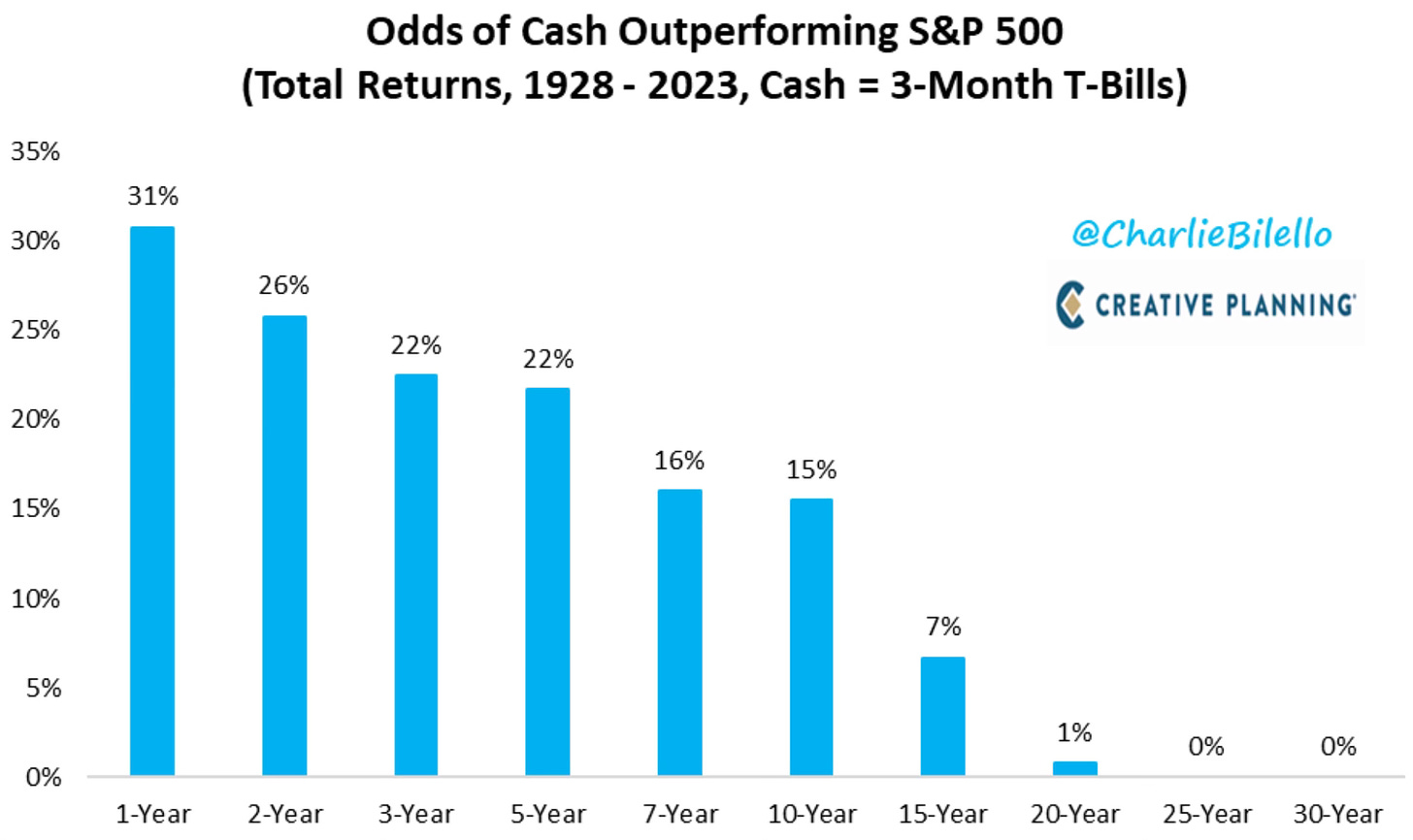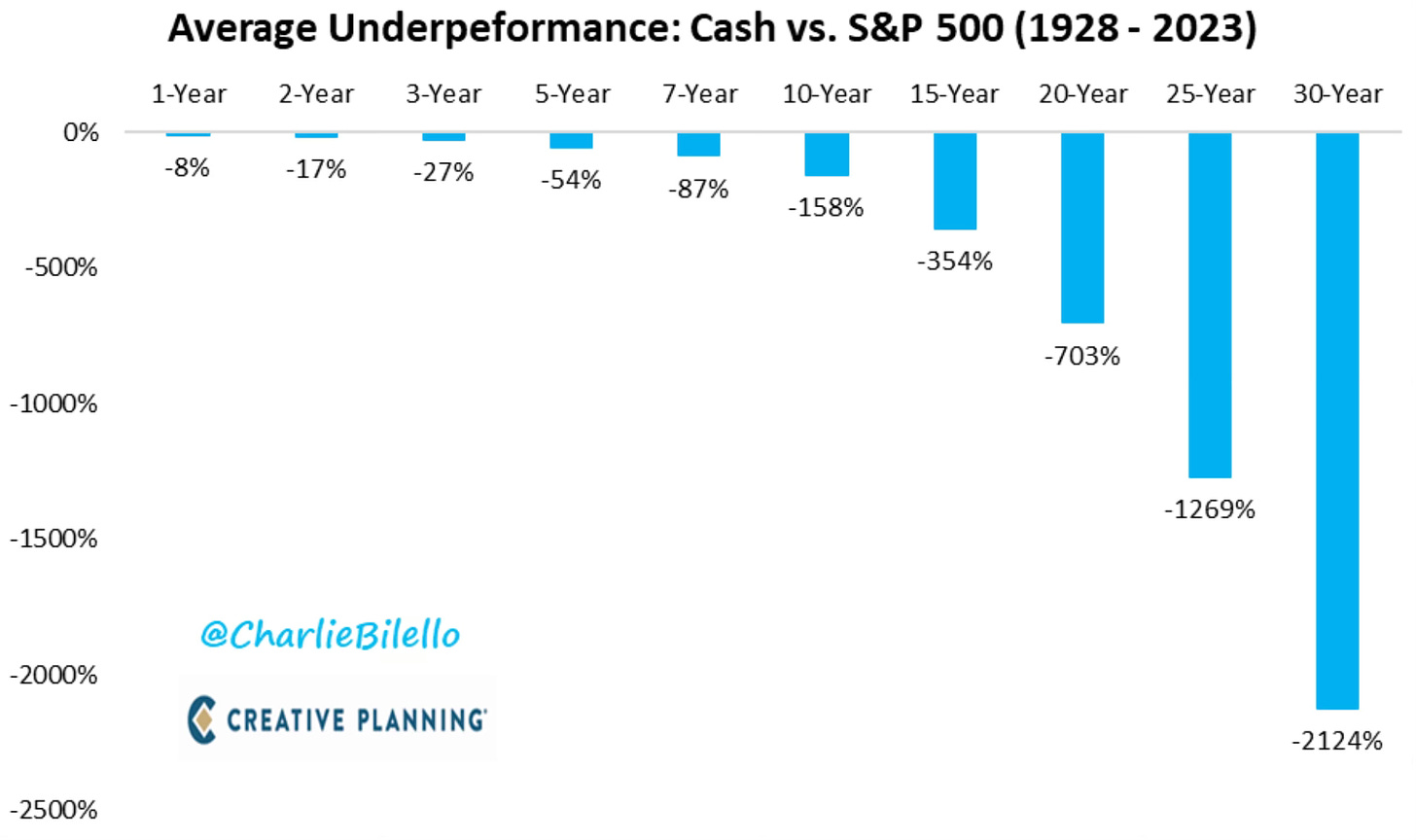My last post generated some conversations about the road ahead and where opportunities may be in the stock market. As some of us discussed where the path ahead may be, we kept coming back to the same place for answers. The large pile of cash that is sitting in money markets. Where does some of that end up?
I wrote about this and the possible impact it may have on the stock market in my 2024 outlook, Investing Update: 2023 Recap & 2024 Outlook. It contained the following;
If we’re going to see an up market again in 2024, what pushes it higher? I think one of the important pieces as we enter 2024 is the amount of cash that is not in stocks.
Just look at the record inflows to cash that we saw in 2023.

As we know institutional money is what moves the stock market. And what do they have a lot of? Cash! Try the most in history.
2023 finished with an all-time high of $6.3 trillion sitting in money market funds. Here is a breakdown by the large financial institutions.

Bob Elliott also noted in this chart how low equity allocations are relative to how near all-them highs the stock market is at. People are still underinvested in stocks. The higher the market goes, the more amounts of this cash will find their way into stocks.

Now three weeks into 2024 and we’re at new all-time highs in the stock market.
What also has continued is the flow into money market funds. From BofA via
;Money market funds have seen $163bn in inflows over the first 2 weeks of 2024, the strongest start to a year ever.

The record-high amount of cash on the sidelines in money market funds continues to grow to now upward of over $6 trillion. It does coincide with the Fed raising interest rates. Clearly a sign of money rolling in to chase the higher yields. It came out of banks and the higher yielding stocks. It went where you could get essentially a risk-free 5% to sit in cash via money markets and CDs.

Here is a chart that combines the assets in money markets and CDs. Both spiked with the rising of rates and the yields they now offer to $8.8 trillion.

During that same time is when we saw the biggest quarterly outflows in almost three years from US dividend funds. Investors chased yields in the safer alternatives of money markets and CDs with less risk, instead of the higher risk of high yielding dividend stocks.

As the Fed starts to roll back their rate hikes in the coming months, we can assume some of this money will find its way back into high dividend stocks. Some will likely go back to other parts of the stock market. It will provide a boost just like Bob Elliott noted earlier in the chart about how overall equity exposure is still lower than historical averages. Bottom line is people are still underinvested in stocks.
Money mangers and institutions get paid to put money to work. They can’t just sit parked in cash. That’s not what they’re paid to do. The longer we sit at or continue to make new all-time highs, while the consensus is a Fed that is going to start lowering rates, will force that money back into the stock market.
Another side of the high levels of cash, is who is fueling this rush to cash. To my surprise, we’re seeing younger investors increasing their cash allocations.
This is a great chart from Callie Cox on the large amount of cash that people age 18-44 have recently allocated.

Why would young people be increasing their cash holdings?
This would line up with the rise in mortgage rates and the slowing housing market. One reason is that’s the downpay money used for home purchases. They’re raising cash levels for possible home purchases when mortgage rates ease.
In fact, existing home sales have fallen in December to the lowest levels since August 2010.

It could also be used to increase emergency and rainy day funds. But it does show that there is a large amount of cash sitting waiting to be deployed for possible home purchases, home improvements, stock market deployment or just to further consumer spending. All positives in my view.
One more point on cash is that cash needs to be viewed as a short-term liquidity holding. It’s not a long-term replacement for equities. Many like the safety that cash affords. But to use it as an alternative to investing is doing a disservice and isn’t financially smart.
Here are two charts that paint the picture of cash versus the S&P 500 from 1928 through 2023.
The first is the odds of cash outperforming the S&P 500. Terrible odds!

Then here is the average underperformance of cash versus the S&P 500. Gigantic underperformance!

Cash provides a sense of safety and it’s important to always have some. Just don’t confuse it as a replacement for long-term investing in the stock market.
The Coffee Table ☕
After hearing all the rave reviews of the movie Past Lives, my wife and I decided to watch it. It was a good movie. I was a bit underwhelmed as I may have had too high of expectations. This type of movie isn’t one I would typically watch. It’s a good story and the movie is very captivating and deeply moving. I can definitely see why so many people really like it.
I came across this which was shared by Doug Boneparth. I found it quite funny and completely agree with it. When I showed it to my wife she chuckled and said yes that is true.

Thank you for reading! If you enjoyed Spilled Coffee, please subscribe.
Spilled Coffee grows through word of mouth. Please consider sharing this post with someone who might appreciate it.
Order my book, Two-Way Street below.



